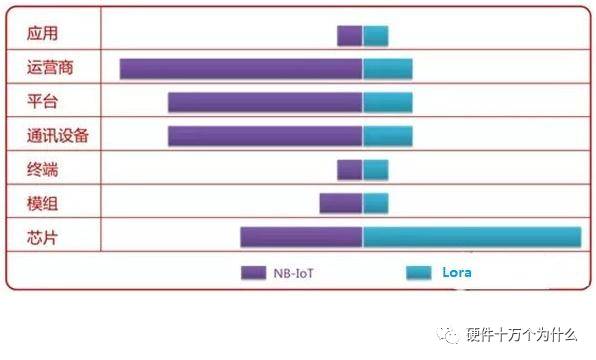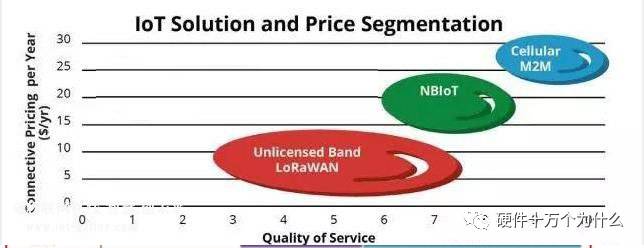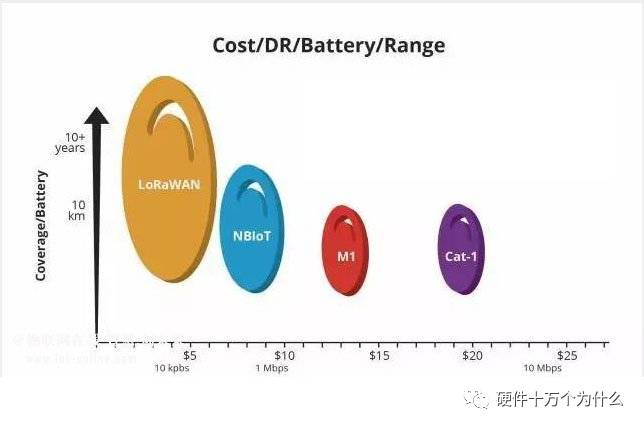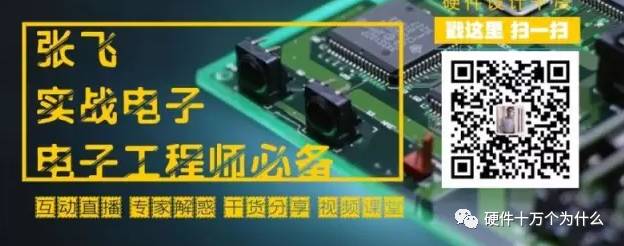1. Introduction IoT applications need to consider many factors, such as node cost, network cost, battery life, data transmission rate (throughput), latency, mobility, network coverage, and deployment type. It can be said that no single technology can meet all the needs of IoT. The two technologies, NB-IoT and LoRa, have different technical and commercial characteristics, leading to different application scenarios. This article will elaborate on the differences between the two and explain their respective suitable application scenarios.
From the perspective of industrial development, a complete industrial chain has formed, consisting of seven major links: chips, modules, terminals, communication devices, platforms, operators, and applications. I have collected a comparison chart of the market concentration of NB-IoT and LoRa in each link; let’s take a look at the differences between the two from this perspective.

2. Frequency Bands, Quality of Service, and Costs LoRa operates in unlicensed frequency bands below 1GHz, so there is no additional payment required for application. NB-IoT and cellular communication use licensed frequency bands below 1GHz. The frequency bands between 500MHz and 1GHz are optimal for long-distance communication because the actual size and efficiency of the antenna have significant advantages. LoRaWAN uses free unlicensed frequency bands and is an asynchronous communication protocol, making it the best choice for battery-powered and low-cost applications. The LoRa and LoRaWAN protocols have unique characteristics in handling interference, network overlap, and scalability but cannot provide the same Quality of Service (QoS) as cellular protocols. It is reported that the auction price for licensed Sub-GHz frequency bands exceeds 500 million USD per MHz. Due to QoS considerations and high frequency usage fees, applications that require guaranteed QoS are recommended to use cellular networks and NB-IoT, while LoRa is a good choice for low-cost and massive connections, as shown in the figure below.

3. Battery Life and Downlink Latency The design philosophy of cellular networks is optimal frequency band utilization, which sacrifices node cost and battery life. In contrast, LoRaWAN nodes are designed for low cost and long battery life, which has some shortcomings in frequency band utilization. Two important factors need to be considered regarding battery life: the current consumption of the node (peak current and average current) and the protocol content. LoRaWAN is an asynchronous ALOHA-based protocol, meaning nodes can sleep for varying durations based on specific application requirements, whereas nodes in synchronous protocols like cellular must connect to the network periodically. For example, current mobile phones must synchronize with the network every 1.5 seconds during operation. In NB-IoT, this synchronization occurs less frequently but still periodically, consuming additional battery power. Modulation in cellular networks is an effective means of utilizing frequency bands, but from the node’s perspective, it is not efficient. Cellular modulation (OFDM or FDMA) requires a linear transmitter to generate modulated signals, and a linear transmitter requires several orders of magnitude more peak current than non-linear modulation, leading to greater battery consumption. However, synchronous communication protocols have advantages in shorter downlink latency, and NB-IoT can provide fast data transmission rates for applications requiring high data throughput. LoRaWAN’s Class B reduces downlink communication latency by periodically waking up terminals to receive downlink messages (programmatically). Therefore, for applications requiring frequent communication, shorter latency, or larger data volumes, NB-IoT may be a better choice, while LoRa is better for lower costs, higher battery life, and infrequent communication scenarios.

4. Network Coverage and Deployment Timeline The essential requirement for node operation is network coverage. A clear advantage of NB-IoT is that it can provide network deployment by upgrading existing network facilities, but this upgrade is limited to certain specific 4G/LTE base stations and is costly. Moreover, this upgrade is only suitable for urban areas that already have 4G/LTE coverage and is not suitable for remote or suburban areas without 4G coverage. The NB-IoT standard was announced in June 2016, with modules expected to be mass-produced and released in the first half of 2017. In addition to network deployment, the corresponding commercialization and establishment of the industrial chain will require more time and effort to explore, but will the market demand and opportunities wait? The entire LoRa industrial chain is relatively mature, and products are in a state of readiness, with many countries around the world conducting or completing nationwide network deployments. A prominent advantage of the LoRa industrial chain is that each member in the chain has autonomy; some large companies are planning to create a hybrid business model to deploy networks and applications. However, the NB-IoT industrial chain will be limited by frequency bands and operators.
5. Device Costs, Network Costs, and Hybrid Models For terminal nodes, the LoRaWAN protocol is simpler and easier to develop than NB-IoT, and it has better applicability and compatibility with microprocessors. The modulation mechanism and protocol of NB-IoT are more complex, requiring more complicated circuits and higher costs, and like 3GPP, NB-IoT has taxation. Currently, the tax for a mobile phone is about 5 USD, which is too expensive for IoT devices, and if the tax is rashly reduced, it could disrupt prices in the mobile communication market for devices like mobile phones. Therefore, how the 3GPP organization balances the tax issues between IoT and mobile communications is also a significant problem. Low-cost, relatively mature LoRa modules can already be found on the market, and upgraded versions will follow. The LoRa Alliance has few copyright and tax restrictions, making it quite feasible for modules in the LoRa industrial chain to be below 4 USD. Currently, the price of LoRa modules on the market typically ranges from 7 to 10 USD, but with increased technological maturity, 4 to 5 USD is not a significant issue. In contrast, it is challenging for an LTE module price to fall below 20 USD. Compared to traditional networks relying solely on “towers,” IoT and LPWAN deployments require different models to reduce expenditure and operational costs. LoRaWAN deployment incurs lower costs because it can utilize traditional signal towers, industrial base stations, or even portable home gateways. Currently, a tower-based base station costs around 1000 USD, industrial base stations cost less than 500 USD, and home gateways cost about 100 USD. However, for NB-IoT, upgrading existing 4G LTE base stations conservatively costs no less than 15,000 USD each.
6. Application Examples As previously mentioned, no single technology can meet all the needs of IoT applications simultaneously. Below, we will analyze specific application examples to illustrate the suitable application scenarios for NB-IoT and LoRa. A: Smart Meters In the smart meter sector, relevant companies and departments require high-rate data transmission, frequent communication, and low latency. Since smart meters are powered by electricity, there is no demand for ultra-low power consumption and long battery life. Additionally, real-time monitoring of the power grid is needed to address potential issues promptly. LoRaWAN’s Class C can achieve low latency, but for high transmission rates and frequent communication needs, NB-IoT is a better choice for smart meters. Moreover, smart meters are generally installed in fixed locations in densely populated areas, making them easier for operators to manage. B: Smart Agriculture For agriculture, low-power, low-cost sensors are urgently needed. The application of sensors for temperature, humidity, carbon dioxide, and salinity is crucial for improving agricultural yield and reducing water resource consumption; these sensors need to upload data periodically. LoRa is highly suitable for such scenarios. Furthermore, many remote farms or fields do not have cellular network coverage, let alone 4G/LTE, making NB-IoT less suitable for smart agriculture than LoRa. C: Automated Manufacturing Factories require real-time monitoring of machine operations to ensure production efficiency and improve labor efficiency through remote monitoring. In automated manufacturing and production in factories, there are many different types of sensors and devices. Some scenarios require frequent communication and ensure good Quality of Service (QoS), making NB-IoT a more suitable choice. Other scenarios require low-cost sensors with low power consumption and long battery life to track equipment and monitor status, making LoRa a reasonable choice. Therefore, both NB-IoT and LoRa have their place in the diversity of automated manufacturing. D: Smart Buildings For building renovations, integrating sensors for temperature, humidity, safety, harmful gases, and water flow monitoring and periodically uploading monitoring information facilitates management oversight and user convenience. Generally, these sensors do not require particularly frequent communication or exceptionally good Quality of Service, and a portable home gateway can meet the needs. Thus, LoRa is a more suitable choice for this scenario. E: Retail Terminals (POS) Retail terminal (POS) systems often require frequent and high-quality communication, and these devices typically have dedicated power sources, so there is no requirement for long battery life. Additionally, there are high requirements for communication timeliness and low latency. Therefore, based on the above considerations, NB-IoT is more suitable for this application. F: Logistics Tracking Tracking or locating is an important demand in the market for terminal battery life. Logistics tracking can serve as a practical example of hybrid deployment. Logistics companies can deploy networks based on location needs, whether in warehouses or transport vehicles, where portable base stations come into play. LoRa can provide such deployment solutions, while for NB-IoT, the extensive tracking range poses significant challenges for base station deployment. Additionally, LoRa has a characteristic that communication is relatively more stable than NB-IoT during high-speed movement. Based on the above considerations, LoRa is better suited for logistics tracking.
7. Conclusion There is no undisputed choice in the field of IoT; each application scenario has its unique needs and considerations. This article elaborated on the characteristics and business models of both NB-IoT and LoRa, and it is believed that both will have a place in the IoT market.
—————Advertisement—————
